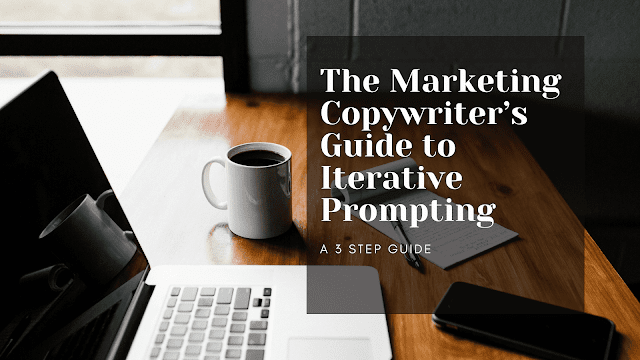A Guide to Iterative Prompting for the Marketing Copywriter
This content has been lightly edited by various GenAI to fit my own style. Original (100% human written) draft below.
Generative AI can churn out marketing materials like email campaigns (EDMs), landing pages, and blog posts at lightning speed. However, the content can sometimes be... off, to put it lightly. That's where you, the marketing copywriter, come in.
AI excels at repetitive tasks, freeing you to focus on strategic thinking and crafting compelling narratives that drive results. Here's a 3-step process to leverage AI for a workable first draft you can refine:
Step 1: Prime Your AI
Pre-requisite: Create a document specific to the product or service, not the company. This helps the AI stay on track.
DO NOT SKIP THIS! Prime your AI by giving it context and testing its understanding. Here are some sample prompts:
- Hey Gemini, tell me about the features of [product name] and why [target audience] would find it valuable.
- Perplexity, explain the benefits of [service name] by [company name] in simple terms.
- ChatGPT, explain the benefits of [XX] product by [company] and the problems it solves.
This helps establish context, identify the target market, and understand the product's value proposition.
Step 2: Generate a Template-Based Draft
Once your AI is primed, start prompting it to create specific marketing materials. EDMs are a good starting point since they often follow a template. Here's a sample prompt for an EDM:
Give me an EDM promoting [product name] to a [target audience] audience. Use the following format:
- Subject line
- Preheader
- Short visual copy
- Body copy conveying excitement in a professional and helpful tone
- Three bullet points highlighting how [product name] helps readers achieve [desired outcome]
- Short call to action (CTA)
Because EDMs are widely templated online, an AI that can't handle this is probably a shitty one to consider using for marketing. Ideally by now, your chosen AI should deliver a workable first draft – whether it's a script, EDM, or landing page.
Step 3: Edit with Your Human Expertise
You have two options:
- Tweak the AI output: Edit directly within the AI platform.
- Refine in your preferred word processor: Paste the AI draft and apply your copywriting skills.
This step is crucial – AI can't replicate a human copywriter's expertise. There's no substitute for your marketing copywriting skills. Polish the content, ensuring it aligns with your goals and resonates with your target audience. Don't assume AI outputs are error-free – always leave time to edit extensively.
Conclusion:
By priming your AI, providing a clear outline, and applying your human touch, you can leverage AI to generate a solid marketing copy foundation. Remember, AI is a tool to amplify your skills, not replace them.
This approach allows you to:
- Free up time: Spend less time on repetitive tasks and more time on strategic initiatives.
- Enhance creativity: Use AI-generated ideas as a springboard for your own creative thinking.
- Drive results: Create compelling and effective marketing copy that resonates with your target audience.
Author's note: The above is pretty standard what I call "marketing tone of voice" in which most of it has been written to be pretty inoffensive. While it's great as a start, remember that it's no substitute for the display of human emotion, which you'll see below.
The original draft:
Generative AI can speed up the creation of templated and regular marketing materials, such as EDMs, landing page copy, blog articles, and more. However, the biggest issue is that sometimes, it just straight up hallucinates the content - which is where you, the marketing copywriter comes in. No one knows how to introduce and entice people to try your organisation’s product like you do, and GenAI can be uniquely powerful to helping you regain time lost working on mindless repetitive tasks, so you can focus on the bigger creative strategies that drive the business forward.
That’s not to say that GenAI is Absolutely Invincible, but with these three steps, you should have a workable initial first draft that you can refine in a much shorter period of time than if you’d have to make it from scratch.
3 Steps to a Working First Draft
Step 1: Prime your AI
Sample prompts
- Hey Gemini, tell me what you know about [XX] product, and why [my target audience] would be interested in it.
- Perplexity, what is [XX] service? Explain to me like I’m 10.
- Chat, explain the benefits of [XX] product by [company/organisation name] and the problems it solves.
Step 2: Templatise your first draft
- Subject line
- preheader
- short visual copy
- body copy that conveys excitement in a professional and happy to help tone
- three short bullet points on how XX product can help readers [achieve outcome]
- short CTA.
Step 3: Edit, edit, edit!
Conclusion
- Prime your AI
By giving it context and testing its understanding. - Give it an outline
By detailing exactly what you want and how you want it. - Edit, edit, edit!
It's not quite a finished product, but this is where your skills, experience, and human empathy will shine.
And with that said, I hope this has been a help!
Credits: Image by Andrew Neel on Unsplash.

Comments
Post a Comment